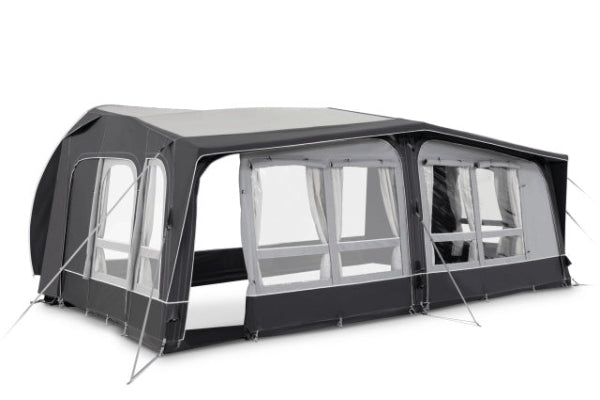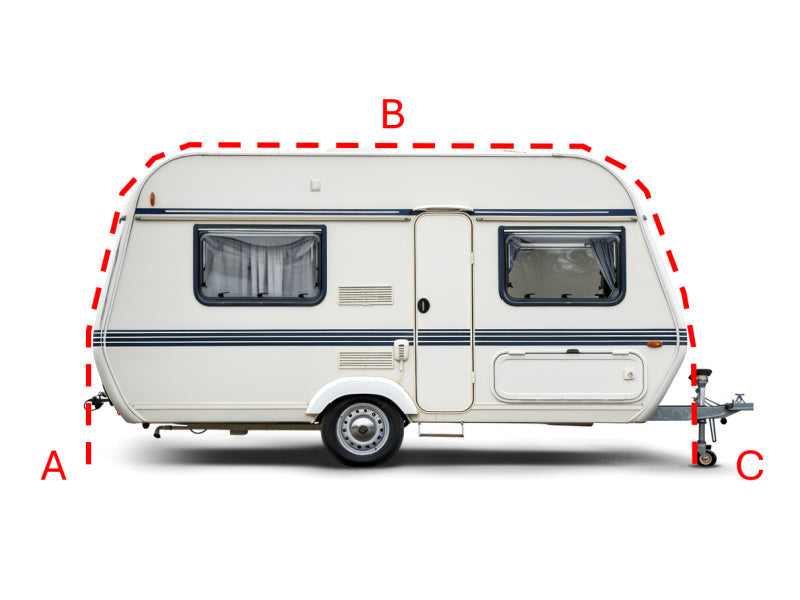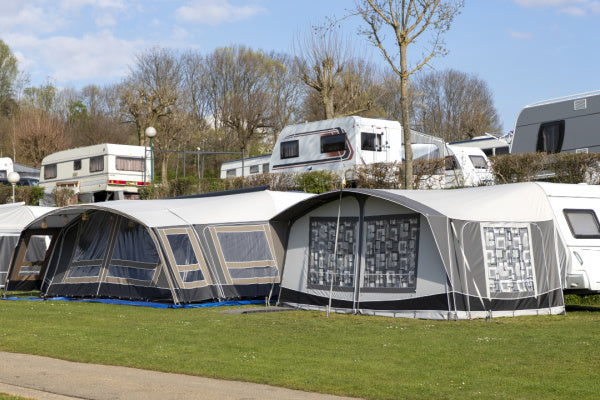What Are Caravan Awnings Made of?
Did you know that caravan awnings are essentially your mobile home's front porch? They're primarily made from polyester, PVC, and canvas, supported by aluminium or fibreglass frames. Whether you're a weekend warrior or full-time caravanner, understanding these materials could save you from soggy camping disasters and costly mistakes.

Common Caravan Awning Materials
Acrylic
Acrylic stands out as the premium choice in the world of caravan awnings. This sophisticated material excels in UV protection, keeping the harsh sun at bay while maintaining its vibrant colour season after season.
The breathable nature of acrylic makes it particularly effective in preventing condensation build-up during those chilly morning starts. Its natural resistance to mould and mildew proves invaluable during extended trips in varying weather conditions.
While the initial cost might raise eyebrows, acrylic's exceptional durability often proves more economical over time. The material's resilience against fading and wear means fewer replacements and sustained performance throughout countless adventures.
Polyester
Modern caravan enthusiasts often gravitate toward polyester awnings, and for good reason. This versatile material strikes an impressive balance between performance and affordability.
The lightweight nature of polyester makes setup and takedown significantly less demanding. Quick-drying properties ensure the awning can be packed away promptly after morning dew or unexpected showers.
Most polyester awnings come with specialised treatments that enhance their water resistance and UV protection capabilities. However, breathability can sometimes be compromised compared to natural alternatives.

Canvas
Traditional canvas awnings hold a special place in the caravanning world. Their time-tested performance and natural characteristics continue to appeal to many outdoor enthusiasts.
Modern canvas undergoes sophisticated treatment processes to enhance water resistance without sacrificing its inherent breathability. The material creates a comfortable microclimate underneath, perfect for those warm summer evenings.
The trade-off comes in weight and maintenance requirements. Canvas demands more attention to prevent mould growth and maintain its protective properties. Yet many find its classic appeal and natural feel worth the extra effort.
PVC Coated Polyester
PVC coated polyester represents modern engineering at its finest. This hybrid material combines the best qualities of both materials to create something truly remarkable.
The coating provides superior waterproofing while the polyester base maintains structural integrity. Cleaning becomes remarkably straightforward - often requiring nothing more than a quick wipe down.
This material particularly shines in challenging weather conditions. Its robust nature handles everything from heavy rain to strong winds with impressive resilience.
Cotton
Cotton awnings might seem old-fashioned, but they offer unique benefits that some caravanners still prize. Their natural breathability creates an exceptionally comfortable environment in warm weather.
Modern treatments enhance cotton's natural properties, adding water resistance while maintaining its characteristic feel. However, these awnings require careful maintenance and proper drying to prevent deterioration.
The material's weight and drying time make it less practical for frequent travellers. Yet for seasonal pitches or longer stays, cotton can provide unmatched comfort.
Material Considerations
Durability and Weather Resistance
Weather resistance varies significantly between materials. Each option provides different levels of protection against rain, UV rays, and wind.
Synthetic materials typically offer superior water resistance but might struggle with UV degradation over time. Natural fibres often provide better temperature regulation but require more weather-proofing maintenance.
The lifespan of an awning largely depends on its material composition and care routine. Regular maintenance can dramatically extend the service life of any awning material.

Ease of Maintenance
Maintenance requirements should factor heavily into material selection. Synthetic materials typically demand less regular attention, making them ideal for frequent travellers.
Natural fibres need more consistent care but often reward the extra effort with superior comfort. PVC-coated materials offer perhaps the easiest maintenance routine, usually requiring simple cleaning procedures.
Proper storage practices matter regardless of material choice. Even the most durable awning can suffer from improper storage techniques.
Aesthetics
Visual appeal plays a crucial role in awning selection. Different materials offer varying aesthetic possibilities through colours, patterns, and textures.
Acrylic provides the broadest range of design options, maintaining its appearance admirably over time. Canvas and cotton deliver a classic, timeless look that many find appealing.
Modern synthetic materials can replicate various finishes while offering superior weather resistance. The key lies in matching aesthetic preferences with practical requirements.
Cost
Initial purchase price tells only part of the story. The true cost of an awning includes maintenance requirements, expected lifespan, and replacement frequency.
Premium materials like acrylic command higher prices but often prove more economical through extended service life. More affordable options might need replacement sooner but suit occasional users perfectly well.
Consider usage patterns when evaluating cost-effectiveness. Frequent travellers might benefit from investing in more durable materials, while occasional users might find budget-friendly options more suitable.
Caravan Awning Frames
The framework of a caravan awning plays just as crucial a role as the material it supports. A robust frame ensures stability in challenging weather and contributes significantly to the awning's overall longevity.
Steel Poles
Steel represents the traditional choice for caravan awning frames. These robust poles offer unmatched stability and durability in demanding conditions.
The substantial weight of steel poles provides excellent resistance against strong winds. However, this same weight makes them more challenging to transport and set up.
While steel requires protection against rust, proper maintenance can ensure these poles last for many camping seasons. They're particularly popular for seasonal pitches where the awning remains in place for extended periods.
Aluminium Poles
Aluminium has revolutionised awning frame design with its exceptional strength-to-weight ratio. These lightweight poles make setup and transportation significantly easier while maintaining impressive structural integrity.
Modern aluminium poles often feature advanced locking mechanisms and adjustable heights. Their natural corrosion resistance makes them particularly suitable for coastal camping environments.
The material's flexibility helps absorb wind pressure rather than fighting against it. While potentially more expensive than steel, aluminium's convenience and durability often justify the investment.
Fibreglass Poles
Fibreglass poles offer a modern solution combining flexibility with remarkable strength. Their lightweight nature makes them especially popular for touring caravanners who frequently set up and take down their awnings.
These poles excel in windy conditions thanks to their ability to flex without breaking. The material's natural resistance to rust and corrosion eliminates many maintenance concerns.
However, fibreglass can become brittle over time with exposure to UV rays. Quality varies significantly between manufacturers, making careful selection crucial.
Air Frames
The latest innovation in awning support comes in the form of air frames or air beams. These inflatable supports eliminate traditional rigid poles entirely, revolutionising the setup process.
Air frames inflate quickly using a pump, dramatically reducing setup time and effort. The absence of rigid components makes storage and transportation remarkably straightforward.
While initially met with scepticism, air frame technology has proven surprisingly robust. Many modern designs incorporate multiple air chambers for added safety and stability.
These inflatable systems perform particularly well in varying weather conditions, as they can flex and adapt to wind pressure. However, they do require careful handling to prevent punctures and regular pressure checks during use.
Other content you might like:
- What is the best material for a caravan awning?
- How long should a caravan awning last?
- Cost of replacing caravan awning
- Are caravan awnings universal?
- How wide are caravan awnings?
- Does a caravan awning need to be exact?
- Will a caravan awning fit a motorhome?
- Can you put a smaller awning on a caravan?
- What is the best sealant for caravan awning rail?





Leave a comment